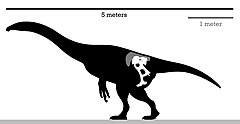Enigmosaurus
| Enigmosaurus | |
|---|---|

| |
| Skeletal diagram of the holotype | |
| Scientific classification | |
| Domain: | Eukaryota |
| Kingdom: | Animalia |
| Phylum: | Chordata |
| Clade: | Dinosauria |
| Clade: | Saurischia |
| Clade: | Theropoda |
| Clade: | †Therizinosauria |
| Superfamily: | † Therizinosauroidea
|
| Genus: | †Enigmosaurus Barsbold, 1983 |
| Type species | |
| †Enigmosaurus mongoliensis Barsbold, 1983
| |
Enigmosaurus (meaning "Enigma lizard" or "Enigmatic lizard") is a
Discovery and naming

The

Three years later, the
Possible synonymy with Erlikosaurus
Some
Description

Enigmosaurus was a relatively large-bodied therizinosaur, with an estimated length of 5 m (16 ft) and a weight between 454 to 907 kg (1,001 to 2,000 lb).[13] As noted by Barsbold in the original description of Enigmosaurus, it can recognised by the following characteristics: the pubis and ischium are short; elongated margin in the anterior presymphyseal region of the distal pubis.[3] However, in the revised diagnosis by Zanno et al. 2010, there are even more specific traits for Enigmosaurus that were not pointed out/analyzed before: prominent cranial and caudal processes on the dorsoventrally somewhat flattened pubic boot; the pubic feet are fused, being medially elongated, a medial expansion forms a V-shaped structure; the medial fusion of the obturator process and pubic body, forms a tetraradiate process.[5]

The holotype pelvis is in relatively good preservation, compromising the sacral vertebrae, partial ilium, right and left pubis and the left ischium. The pelvis is somewhat large as a whole and opisthopubic. The ilium is widely positioned and turned externally; it preserves a large cubic process in the posterodorsal area. Elongated pubic peduncles are present in the ilium; the ischial peduncles are more reduced though. The distal end of the pubis is elongated, recurved and stocky. The ischium, is slightly shorter than the pubis and parallel to it, with a narrow shaft. The obturator process on the front edge of the ischium is horizontally elongated and low. Open edges are appreciable on the large trochanteric fossa. Apparently, the sacrum preserves six vertebrae, with elongated transverse processes.[3] For instance, its pelvis is very particular compared to other therizinosaur relatives, featuring areas of bone resorption and bone remodeling on the ilium. These specific traits may indicate the advanced age of the individual, if true, the fusion of the obturator process and pubic body could be discarded as an authentic autapomorphy for the species. Zanno noted that more analyses are required to settle this enigma.[5]
Classification
Enigmosaurus was by the describers assigned to a separate

Below are the results of the recently performed
| Therizinosauria |
| ||||||||||||||||||||||||||||||||||||
Paleoecology
The remains of Enigmosaurus were found in sediments that were deposited during the Late Cretaceous period on the Bayan Shireh Formation, Khara Khutul locality, about 95.9 ± 6.0 million to 89.6 ± 4.0 million years ago, Cenomanian-Santonian ages.[3][14] Being a therizinosaur, it was likely a slow herbivore and/or omnivore, as suggested by most authors all over the time.[15][16][17] The biodiversity across the formation was characterized by therizinosaurs, as seen on the remains of Enigmosaurus, Erlikosaurus and Segnosaurus.[18] The holotype location, Khara Khutul, has also yielded the contemporary Segnosaurus[2] and an unnamed velociraptorine.[19][20] Most of the remaining paleofauna from this formation is known from Upper strata, whereas Enigmosaurus is known from Lower strata.[10]
At the locality, diverse paleoflora has been discovered, such as
See also
- Timeline of therizinosaur research
- Rinchen Barsbold
- Glossary of dinosaur anatomy
- Anatomical terms of location
References
- S2CID 4348297.
- ^ a b c Barsbold, R.; Perle, A. (1980). "Segnosauria, a new suborder of carnivorous dinosaurs" (PDF). Acta Palaeontologica Polonica. 25 (2): 190–192.
- ^ a b c d e f g Barsbold, R. (1983). "Хищные динозавры мела Монголии" [Carnivorous dinosaurs from the Cretaceous of Mongolia] (PDF). Transactions of the Joint Soviet-Mongolian Paleontological Expedition (in Russian). 19: 89. Translated paper
- .
- ^ S2CID 53405097.
- ISBN 9780520242098.
- ISBN 978-0-6911-3720-9.
- ISBN 0-7853-0443-6.
- hdl:2246/3712.
- ^ PMID 30995236.
- PMID 23284972.
- ^ PMID 31333906.
- ^ Holtz, T. R.; Rey, L. V. (2007). Dinosaurs: The Most Complete, Up-to-Date Encyclopedia for Dinosaur Lovers of All Ages. Random House. Genus List for Holtz 2012 Weight Information
- .
- JSTOR 4523011.
- PMID 27069815.
- S2CID 133643430.
- S2CID 197584839.
- .
- S2CID 83572446.
- ISBN 9780444502766.
- S2CID 86032547.
